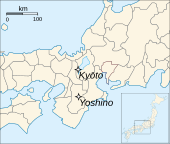Kenmu
| Part of a series on the |
| History of Japan |
|---|
 |
Kenmu (建武) was a Japanese era name of the Northern Court during the Era of Northern and Southern Courts after Shōkei and before Ryakuō. Although Kemmu is understood by the Southern Court as having begun at the same time, the era was construed to have begun after Genkō and before Engen.
This period spanned the years from January 1334 through August 1338 in the North,[1] and until only February 1336 in the Southern Court.[2] The reigning Emperors were Emperor Go-Daigo in the south and Emperor Kōmyō in the north.[3]
Nanboku-chō overview
[edit]
During the Meiji period, an Imperial decree dated March 3, 1911, established that the legitimate reigning monarchs of this period were the direct descendants of Emperor Go-Daigo through Emperor Go-Murakami, whose Southern Court been established in exile in Yoshino, near Nara.[4]
Until the end of the Edo period, the militarily superior pretender-Emperors supported by the Ashikaga shogunate had been mistakenly incorporated in Imperial chronologies despite the undisputed fact that the Imperial Regalia were not in their possession.[4]
This illegitimate Northern Court had been established in Kyoto by Ashikaga Takauji.[4]
Change of era
[edit]- 1333, also called Kenmu gannen (建武元年): The new era name was created to mark an event or series of events. The previous era ended and the new one commenced in Shōkei 1 as time was reckoned in the Northern Court in Kyoto; and the era began in Genkō 4, as time was ordered in the Southern Court in Yoshino.
Events of the Kenmu era
[edit]- 1333–1336 (Kenmu): The Kenmu Restoration was an attempt by Emperor Go-Daigo to restore Imperial authority after the fall of the Kamakura shogunate. The short-lived restoration was thwarted by Ashikaga Takauji who established a new bakufu which came to be known as the Ashikaga shogunate or the Muromachi shogunate. The failure of the restoration resulted in the creation of two rival Imperial courts which struggled for supremacy until 1392.[5]
- 1334 (Kenmu 1): Emperor Go-Daigo caused Kenmu nenchū gyōji to be written. This was a book which described the ceremonies of the court; and its purpose was to aid the process of reviving ancient court etiquette.[6]
- October 25, 1334 (Kenmu 1, 27th day of the 9th month): Emperor Go-Daigo made an Imperial progress to Kamo-jinja.[7] No other emperor would visit Kamo's shrines until April 29, 1863 (Bunkyū 3, 11th day of the 3rd month), when Emperor Kōmei made an Imperial progress to Kamo-jinja accompanied by the shōgun, all the principal officials and many feudal lords. This was the first Imperial progress since Go-Mizunoo visited Nijō Castle more than 230 years before.[8]
- 1336 (Kenmu 3): An anonymous author published Kenmu nenkan ki, which was a chronicle of the Kemmu era. The text is a source of information about laws, government, bureaucrats, and arable lands and estates given by the emperor to the nobility or to religious institutions (shōen).[9]
- 1336 (Kenmu 3): Ashikaga Takauji promulgated the Kenmu-shikimoku, which was a legal code with 17 articles addressing the behavior of the nobles.[10][11]
Notes
[edit]- ^ Nussbaum, Louis-Frédéric. (2005). "Kemmu" in Japan encyclopedia, p. 507; n.b., Louis-Frédéric is pseudonym of Louis-Frédéric Nussbaum, see Deutsche Nationalbibliothek Authority File Archived 2012-05-24 at archive.today.
- ^ Nussbaum, Louis-Frédéric. (2005). "Engen" in Japan encyclopedia, p. 178.
- ^ Titsingh, Isaac. (1834). Annales des empereurs du japon, pp. 286-292.
- ^ a b c Thomas, Julia Adeney. (2001). Reconfiguring modernity: concepts of nature in Japanese political ideology, p. 199 n57, citing Mehl, Margaret. (1997). History and the State in Nineteenth-Century Japan. p. 140–147.
- ^ Nussbaum, Louis-Frédéric. (2005). "Kemmu no Chūkō" in Japan encyclopedia, p. 507.
- ^ Nussbaum, Louis-Frédéric. (2005). "Kemmu nenchū gyōji" in Japan encyclopedia, p. 507.
- ^ Ponsonby-Fane, p. 325.
- ^ Ponsonby-Fane, Richard. (1956). Kyoto: The Old Capital of Japan, 794–1869, p. 325.
- ^ Nussbaum, Louis-Frédéric. (2005). "Kemmu nenkan ki" in Japan encyclopedia, p. 507.
- ^ Nussbaum, Louis-Frédéric. (2005). "Kemmu-shikimoku" in Japan encyclopedia, p. 507.
- ^ Sansom, George (1961). A History of Japan, 1334–1615. Stanford University Press. p. 57. ISBN 0804705259.
References
[edit]- Mehl, Margaret. (1997). History and the State in Nineteenth-Century Japan. New York: St Martin's Press. ISBN 978-0-312-21160-8; OCLC 419870136
- Nussbaum, Louis Frédéric and Käthe Roth. (2005). Japan Encyclopedia. Cambridge: Harvard University Press. ISBN 978-0-674-01753-5; OCLC 48943301
- Ponsonby-Fane, Richard Arthur Brabazon. (1956). Kyoto: The Old Capital of Japan, 794-1869.] Kyoto: The Ponsonby Memorial Society. OCLC 36644
- Thomas, Julia Adeney. (2001). Reconfiguring Modernity: Concepts of Nature in Japanese Political Ideology. Berkeley: University of California Press. ISBN 978-0-520-22854-2; OCLC 47916285
- Titsingh, Isaac. (1834). Nihon Odai Ichiran; ou, Annales des empereurs du Japon. Paris: Royal Asiatic Society, Oriental Translation Fund of Great Britain and Ireland. OCLC 5850691
External links
[edit]- National Diet Library, "The Japanese Calendar" -- historical overview plus illustrative images from library's collection
